The X Button
Ageless Beauty
by Todd Ciolek,

As someone who once took journalism classes and learned about the ideals of an objective press, I'm glad that this column lets me throw all of those lessons out the window and be as biased as possible. For a good example, take the recent news of Konami making Castlevania the Adventure Rebirth for the Wii.
The game's title and ratings-board description suggest a 2-D game in the tradition of the early straightforward side-scrolling Castlevanias, just as Contra Rebirth stayed true to that franchise's action-shooter roots. Here's the problem: I don't like the older Castlevanias. In fact, I think that the series was stricken with poor play mechanics and horrible pacing until 1993's Rondo of Blood.
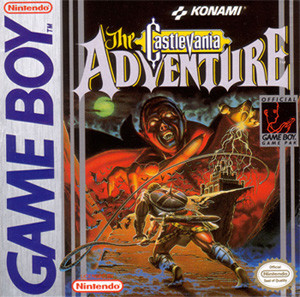
It doesn't help that Castlevania the Adventure Rebirth seems to be based on Castlevania the Adventure, a Game Boy game that might be the worst Castlevania title ever. Yes, worse than that Wii fighting game or those Nintendo 64 aberrations that only devoted Castlevania fans pretend to like.
So I shall let bias reign. Instead of putting Castlevania the Adventure Rebirth in the news section, I'm going to stick it here in my introduction, which is always the most frivolous part of the column. That'll show Castlevania.
NEWS
TOKIMEKI MEMORIAL RETURNS, WONDERS WHAT HAPPENED
Konami's Tokimeki Memorial series of dating simulators is now overshadowed by countless modern descendants, but there was a time in the late 1990s when Tokimeki Memorial stood taller than any other game with schoolgirls and teenage romance. Starting on the PC Engine and evolving through other systems, Tokimeki Memorial enjoyed a profusion of spin-offs, an anime series, “Girl's Side” sims for dating male characters, and even game-of-the-year accolades. Konami released a PSP port of the original in 2006, and recently decided to make Tokimeki Memorial 4 for the system.
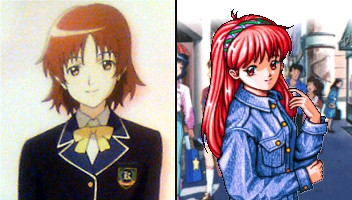
As with the original Tokimeki Memorial and too many other dating sims to name, players control a young man spending his high-school years in the company of several attractive girls, with the player's interactions determining just who ends up in love with our hero. The game's artwork shows a style slightly more simple and anime-like than the earlier games in the series, as shown in comparisons between Tokimeki Memorial 4's Maki Hoshikawa (left) and the original's Shiori Fujisaki (right). Can Tokimeki Memorial triumph in an industry where the eyes are even bigger, the otaku element is stronger, and the maid costumes are more frequent? Tokimeki Memorial still turns up in best-game-ever polls in Japan, so I'd say Konami has little cause to worry.
SONIC THE HEDGEHOG PROMISES TO STOP DRINKING THIS TIME
Each new Sonic the Hedgehog game provokes a variety of amusing responses, from the fans who hate it sight unseen to those who swear that this game, this game, will be the one that returns Sonic to glory and smites Nintendo and rains a terrible judgment upon the unfaithful. However, this new Sonic title might lend itself to the latter's delusions more than usual, since the PR line promises a 2-D Sonic game with an emphasis on speed that “brings Sonic back to his 2-D roots.” On the other hand, it's nicknamed “Project Needlemouse,” which sounds like some episode of the Sonic cartoon too horrible to be aired. The game's home console is unknown, and no screens have yet emerged.
NEW TATSUNOKO VS. CAPCOM CHARACTERS HAVE COVERED WARS, FOUGHT IN SPACE
Word of extra Tatsunoko vs. Capcom characters emerged when the game was first announced for a North American release, with the subtitle of Ultimate-All Stars. Yet Ultimate All-Stars is also showing up in Japan as a special edition of the original Tatsunoko vs. Capcom, known as Cross Generation of Heroes. Got that? Well, the important thing is that Capcom officially confirmed one new face: D-boy from Tekkaman Blade, the mid-1990s space-opera mechanized superhero series that some Western kids saw as Teknoman.
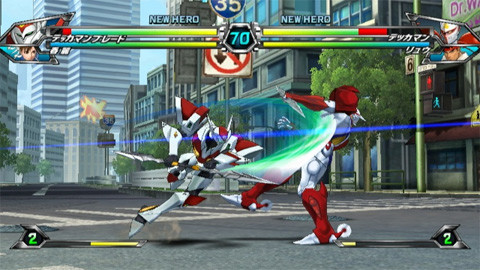
The operative word here is “officially confirmed,” as Capcom's Japanese Tatsunoko vs. Capcom: Ultimate All-Stars website hides the names of the remaining new characters. One enterprising Shoryuken forums member picked through the code and found signs of four other fighters. From the Tatsunoko side, the game draws Ai-Chan (a.k.a. “Yatterman No. 2”) from Yatterman and Joe Asakura from Gatchaman. The Capcom side gets Dead Rising's Frank West, who I pray will have as memorable a quote as Jill Valentine's “I'm a member of S.T.A.R.S.” from Marvel vs. Capcom 2. The other new Capcom addition is Zero, though no one's yet deduced if that's the Zero from the Mega Man X sub-series of the actual Mega Man Zero line.
If this is the final roster for Tatsunoko vs. Capcom, I'm disappointed that there's no Speed Racer, no Samurai Pizza Cats, and no one from The SoulTaker. The game already had Yatterman and Gatchaman characters, after all. Letdowns are inevitable when you're pulling from decades' worth of cartoon history, but Capcom's also going to face my ire over not putting Linn Kurosawa and the entire cast of Cyberbots robots in this thing.
SQUARE ENIX UNVEILS TWO CONTROVERSIAL NIERS
This past E3 saw Square Enix rolling out a trailer for Nier, an action game full of gory violence, apocalypse-shattered cities, and stunning visuals somewhere between Sega's black-and-white Madworld and a full-bore Final Fantasy title. Nier is actually two games: Nier Gestalt on the Xbox 360 and Nier Replicant on the PlayStation 3. Both feature the same white-haired hero named Nier trying to rescue a girl named Yonah, but the details diverge from there: in Replicant, Nier's a young man and Yonah's his sister, while Gestalt has an older, grouchier Nier with Yonah as his daughter.
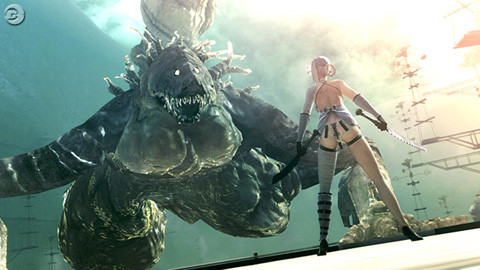
It's an odd way of setting the two games apart, and the supporting cast wanders further into unexpected territory. Nier's sidekick, a talking magical tome named Grimoire Weiss, is nothing out of the ordinary for this genere, but the game also features a sword-wielding (and possibly playable) warrior named Kaine, who, according to Square Enix and a reliable news source, is a hermaphrodite. Half of Kaine's body was hijacked by a demon, and she/he wasn't a particularly happy person prior to that, either, what with the inevitable playground taunting and unkind nicknames. Kaine represents a new idea as far as action games go, and if it's true, half the fun of Nier will be seeing how Square Enix handles Kaine in North America.
IN BRIEF: STAR OCEAN 4 GOES INTERNATIONAL, THE SKY CRAWLERS GETS NEW VOICES, ATELIER RORONA LANDS EUROPEAN RELEASE, SHANTAE FINALLY GETS A SEQUEL
PlayStation 3 owners will get Star Ocean 4: The Last Hope International in Japan first thing this February. Like most of Square Enix's “International” versions, the game features both English and Japanese voice acting, though Star Ocean 4 also includes an option to put the game's text entirely in English. Like other Japanese PlayStation 3 games, it's region-free, and that should please fans who don't want to wait for its likely North American release. Then again, this International version of Star Ocean 4 has the North American game's CG-rendered character portraits that replaced the original game's anime-like art, and there's no indication if players can switch back to the old style.
There's bad news and somewhat neutral news about the North American version of The Sky Crawlers: Innocent Aces, the flight-sim developed by Namco's Ace Combat team and based on Mamoru Oshii's fascinatingly sluggish movie. XSEED Games delayed the game to an early 2010 release, apparently so it can be buried by Tatsunoko vs. Capcom and Bayonetta. When it arrives, it'll also have an English voice track in place of its Japanese one. While countless games of Japanese origin offer dual-language options today, Innocent Aces reportedly lost its Japanese acting due to licensing and disc-space issues.
Atelier Rorona, the latest and prettiest in Gust's long-running Atelier RPG series, is headed for a European release courtesy of that particular continent's branch of Nippon Ichi Software. This assures a North American version of the game, but we have to wait for NIS America to mention it properly. At the very least, Rorona is an interesting evolution in a franchise known for traditional two-dimensional presentation. Not that it's all glitzy 3-D; the battles in Rorona are fancy polygons, but static character cutouts still take up many conversations.
In last-minute news, WayForward finally announced a new Shantae game for the Nintendo DSiWare. The original Shantae is the best GameBoy Color title ever (though that's not saying too much), and a proper sequel has bounced around in limbo for years. Shantae: Risky's Revenge is a three-part game for the DSi's download service, and the first episode will hit this year. More on this next week, after I've stopped dancing a jig in pure joy.
REVIEW: MURAMASA: THE DEMON BLADE
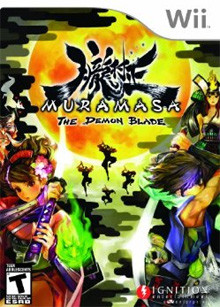 Developer: Vanillaware
Developer: Vanillaware
Publisher: Ignition Games
Platform: Wii
Players: 1
MSRP: $49.99
Muramasa: The Demon Blade stands apart from modern games. In an industry where exceptionally realistic 3-D is an often numbing standard and most 2-D games are simple affairs, Muramasa constructs a world entirely of spectacular hand-drawn samurai stylings. It's standard practice for Vanillaware, the developer of similarly envisioned action-RPGs like Princess Crown and 2007's cult hit Odin Sphere (and the strategy-RPG Grim Grimoire). Muramasa fixes some, if not all, of its predecessors' flaws, emerging onto new ground for Wii action games.
Muramasa needs no long introductions, or any introductions at all, really. Regardless of which of the two characters you play, theirs stories begin in medias res: Momohime is a princess possessed by a demon after an attack on her clan, while Kisuke is a rogue ninja with no memory of why most of his former friends want to kill him. Their stories are steeped in supernatural samurai-film mystique that's a bit more entertaining than Odin Sphere's moron-filled fairy tale, though it's still frequently laden by clichéd twists and dry main characters. Perhaps it's best to take the plot as another part of Muramasa's vast, beautifully drawn stage of mythic drama.
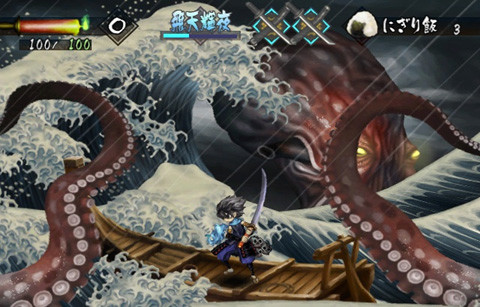
And Muramasa is beautiful indeed. Capturing all manner of spirits and monsters from folklore, it breathes with a deft animation in nearly every character and background, from the crash of waves to the slow tilt of wheat stalks. Muramasa's fantasy realm is the stuff of classical Japanese art, and its recreation of that style would be impressive in concept alone. The characters all move with smooth grace, and even the human-scale warriors are large, detailed figures filling the screen. That's to say nothing of the gigantic creatures that frequently punctuate stages. It's also upheld by music that fits quite well without really standing out, while the voices remain in Japanese with efficient subtitles.
Past Vanillaware games were just as stunning, but flaws persisted throughout them. Princess Crown is a pretty Sega Saturn action-RPG with a deliberately slow and limited battle interface. Odin Sphere takes the same idea and broadens it, resulting in chaotic, frustrating combat that sometimes grinds the PlayStation 2's hardware nearly to a halt. Muramasa solves both problems; its battles are large clashes between Momohime or Kisuke and throngs of enemies, but there's rarely any slowdown or awkward gameplay. Tapping the attack button results in quick strikes, and holding it down allows blocking, dashing, and setting up elaborate mid-air combos. It's easy to pick up, and the variety of large moving targets lets the player try something new quite often.
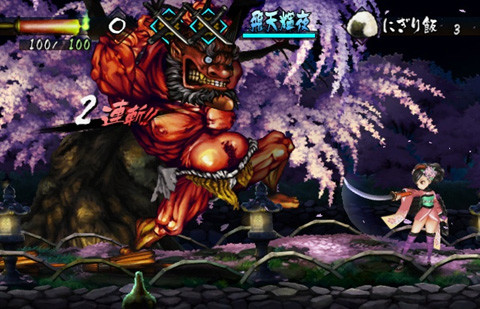
Speaking of large moving targets, Muramasa's best moments arise during its frequent boss battles. Mythical creatures and exaggerated humans show off magnificent jointed animation and excellent art, and most of them are excellent challenges, from a writhing octopus to a lone samurai. If there's a problem, it lies in the bosses' lengthy life meters. In the normal “Muso” mode, it's not much of a problem, but the difficult “Shura” mode can drag out boss encounters into long struggles of attrition. There's also the strange demand that players press “up” to jump, with no option to change that. It gives the game a strangely flat feel, like Guardian Heroes without the line-jumping. Still, Muramasa's control stays relatively tight. Most players will want a Wii Classic Controller or a GameCube pad for Muramasa, but it plays surprisingly well on a nunchuck-and-analog setup.
If the battle system is simplistic, there's plenty going on around it. Momohime and Kisuke each can carry three swords to swap out in the heat of battle, and switching out weapons keeps them from taking too much damage and breaking. Shattered blades can be fixed by popping them back in sheaths for a while, because hey, it's a video game. While there are items to be found and used in battle (and restaurants), it's the sword collection that truly backs Muramasa's dozen or so hours of playtime. Over a hundred swords are hidden in the game, and they all grant varying increases in speed or power, with special attacks available as you change swords. A forge allows players to create new blades, and most of the game's arsenal lies there.
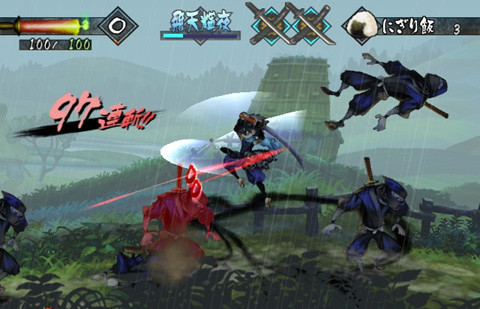
Sadly, Muramasa can't escape all of Vanillaware's common mistakes. As it was with Odin Sphere, there's a lot of backtracking and repeated scenery in Muramasa's quest. It starts up about an hour into Momohime's story, when she runs through one identical multi-level city neighborhood after another. Other levels have Momohime and Kisuke backtracking through stages, now free of enemies, to get to a new path (usually one unlocked with a new sword). It can get quite tedious, even after some shortcuts appears, and I have no idea why Vanillaware didn't cut down on the back-and-forth.
The repetition can grate, but the rest of Muramasa comes together nicely. It's a game driven by its battles and stunning visual punch, and not so much its light RPG dressings or lazily designed stages. Despite some poor design choices, it's far easier to recommend Muramasa than the frequent drudgery of Odin Sphere. Vanillaware is clearly improving, and if Muramasa isn't a standard-setting masterpiece, it's still a fiercely enjoyable spectacle.
RELEASES FOR THE WEEK OF 9-20
AFRIKA  Developer: Rhino Studios
Developer: Rhino StudiosPublisher: Natsume Platform: PlayStation 3 Players: 1-2 MSRP: $49.99 When Afrika was first shown, no one knew what sort of game it was. All we knew was that it showed zebras and hippos and other African wildlife, and they all looked amazing. Sony then decided that it was a photography simulator, one that involves taking shots of all sorts of animals while on safari. The game's photographic options are extensive, as are the detailed environments to explore. It's all from the realistic end of game simulacrums, as opposed to Pokemon Snap. Instead of a plot about local genocide or ivory smuggling, there's a lineup of missions that require you to capture images of creatures within certain time limits or hazardous conditions. Some might shun Afrika and any game with first-person perspectives and no firearms, but there's little question that it's unique.
|
KATAMARI FOREVER  Developer: Namco Bandai
Developer: Namco BandaiPublisher: Namco Bandai Platform: PlayStation 3 Players: 1-2 MSRP: $49.99 Katamari Damacy fans may be a bit jaded at this point, since Namco's stretched out the original game's premise (roll everything into a ball) over five sequels. At least Katamari Forever's setup retains the franchise's wry angle: in order to restore the memories of the King of All Cosmos, players roll up anything they come across to recreate the world and its colors. Forever has a profusion of new stages and graphics filters, plus an offline two-player mode with both cooperative and competitive play, and that's about it for Forever. Still, it's possibly the most visually impressive of Katamari titles, and I imagine series fans might want something to distract them from Katamari creator Keita Takahashi's PSN game Noby Noby Boy by now.
|
SHIN MEGAMI TENSEI: PERSONA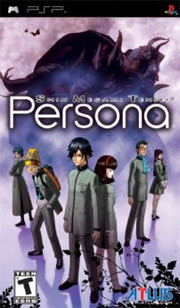 Developer: Atlus
Developer: Atlus Publisher: Atlus Platform: PSP Players: 1 MSRP: $39.99 Free Crap: Preorders get the game's two-disc soundtrack Some didn't know what to make of Persona's modern setting and demon-hunting gameplay when it arrived on the American PlayStation back in 1996. Others knew what to make of it, and they hated it anyway. The PSP remake of Persona marks a second chance for both of these groups and Atlus itself. The original Persona was the victim of often bizarre localization changes, with a subquest removed and one character's race altered. Thanks to Atlus, the PSP version has a new translation, new cinema scenes, and an overworld that doesn't look hideous anymore. For those who entered the series with Persona 3 or 4, the PSP version has simpler treatments of many Shin Megami Tensei series staples: bargains with demons, a sleek and grotesque visual style, and, of course, high-schoolers channeling spirits and destroying monsters. There's no escaping that last one. Atlus plans to release a digital version of this revamped Persona as well, and it'll be out alongside the PSP Go in October.
|
EXTRA LIVES: HARO NO PUYO PUYO
 Kido Gekidan Haro Ichiza: Haro no Puyo Puyo is sheer merchandising genius. Japan likes Puyo Puyo games, right? And Japan likes Gundam, right? And you know how Bandai likes making profitable Gundam games with as little effort as possible? Well, it just so happens that one of Gundam's icons is Haro, a squawking little robot with the same round shape as the colored blobs from Puyo Puyo. I'm just surprised that Haro no Puyo Puyo wasn't made until 2005 on the Game Boy Advance.
Kido Gekidan Haro Ichiza: Haro no Puyo Puyo is sheer merchandising genius. Japan likes Puyo Puyo games, right? And Japan likes Gundam, right? And you know how Bandai likes making profitable Gundam games with as little effort as possible? Well, it just so happens that one of Gundam's icons is Haro, a squawking little robot with the same round shape as the colored blobs from Puyo Puyo. I'm just surprised that Haro no Puyo Puyo wasn't made until 2005 on the Game Boy Advance.
Puyo Puyo games seldom alter the original's gameplay, and Haro no Puyo Puyo certainly doesn't. Just like the round slime creatures of Puyo Puyo, Haros fall onto the playfield in pairs, and linking four or more Haros of the same color makes said Haros disappear. As with Dr. Mario, Super Puzzle Fighter II Turbo and countless other puzzle games, a simple premise soon gives rise to all sorts of sly maneuvers. With the right amount of planning, carefully stacked towers of Haros form chain reactions that rack up points and dump piles of Gundam-brand space mines (or maybe they're robot heads, I'm not sure) on your opponent.
 Haro no Puyo Puyo stages each anime-washed puzzle fight as a duel between cute versions of original Mobile Suit Gundam characters. Amuro Rei, Sayla Mass, Char Aznable, Ramba Ral, Lalah Sune, Bright Noah, M'Quve, and Slegger Law all show up as selectable player avatars, looking like hybrids of standard super-deformed Japanese cartoons and the cast of Home Movies. Though it's a rather slim lineup for a massive franchise like Gundam (No Kacilia? No Kai?), every battle is preceded by an inter-cast squabble with countless echoes of Gundam history. It's still odd that Sega confined the game to the original Mobile Suit Gundam cast, considering that Haros also showed up in Zeta Gundam, Victory Gundam, Char's Really Disappointing Counterattack, and Gundam SEED.
Haro no Puyo Puyo stages each anime-washed puzzle fight as a duel between cute versions of original Mobile Suit Gundam characters. Amuro Rei, Sayla Mass, Char Aznable, Ramba Ral, Lalah Sune, Bright Noah, M'Quve, and Slegger Law all show up as selectable player avatars, looking like hybrids of standard super-deformed Japanese cartoons and the cast of Home Movies. Though it's a rather slim lineup for a massive franchise like Gundam (No Kacilia? No Kai?), every battle is preceded by an inter-cast squabble with countless echoes of Gundam history. It's still odd that Sega confined the game to the original Mobile Suit Gundam cast, considering that Haros also showed up in Zeta Gundam, Victory Gundam, Char's Really Disappointing Counterattack, and Gundam SEED.
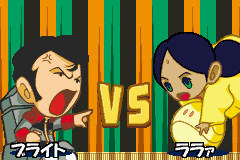 As a puzzle game, Haro no Puyo Puyo is solid, modestly compelling…and pretty much the exact same thing as Puyo Puyo, one of Japan's most ubiquitous games in the genre. Haro no Puyo Puyo offers little beyond a two-player versus mode, a story mode, and a rather empty play-by-yourself mode. Only the Gundam license sets it apart, conveyed with clean visuals and mostly forgettable music. While the characters all grunt and shout and attack each other during puzzle matches, the game lacks the endearing snap of, say, Super Puzzle Fighter II Turbo. For their part, however, the descending Haros are precious: they flap their ears as they fall, smile as they sit in columns, and look at each other with that perpetually curious expression.
As a puzzle game, Haro no Puyo Puyo is solid, modestly compelling…and pretty much the exact same thing as Puyo Puyo, one of Japan's most ubiquitous games in the genre. Haro no Puyo Puyo offers little beyond a two-player versus mode, a story mode, and a rather empty play-by-yourself mode. Only the Gundam license sets it apart, conveyed with clean visuals and mostly forgettable music. While the characters all grunt and shout and attack each other during puzzle matches, the game lacks the endearing snap of, say, Super Puzzle Fighter II Turbo. For their part, however, the descending Haros are precious: they flap their ears as they fall, smile as they sit in columns, and look at each other with that perpetually curious expression.
Yes, Haro no Puyo Puyo is a simple novelty for the Gundam crowd, but it's a novelty that anyone could enjoy. Even if you're no fan of the original Gundam (and I'm not), it's still fun to watch Sayla and Amuro and other Gundam mainstays bicker over pits of cheerful Haros, and the puzzle-game bedrock of it all will never lose its appeal. Considering some of the other places explored by Gundam games, fans could do much, much worse.
Kido Gekidan Haro Ichiza: Haro no Puyo Puyo isn't the most common Gundam game, though it's easily had if you're patient and willing to put $30 toward just another Puyo Puyo game. Also keep an eye out for the Gundam Mahjong games in the same sub-series, available in both original Gundam and Zeta flavors.
discuss this in the forum (39 posts) |
this article has been modified since it was originally posted; see change history